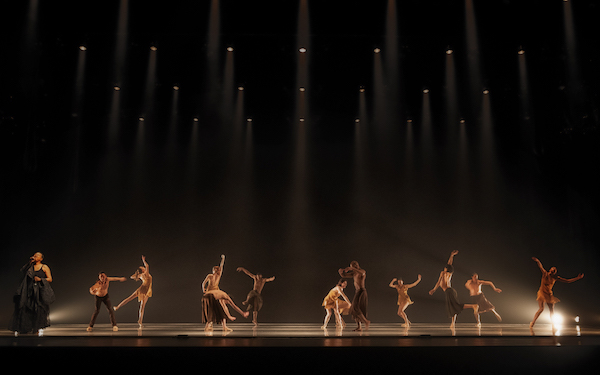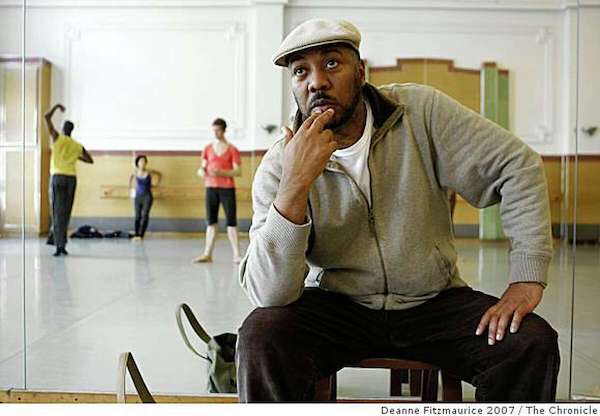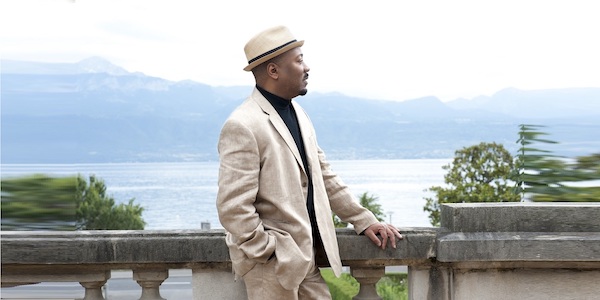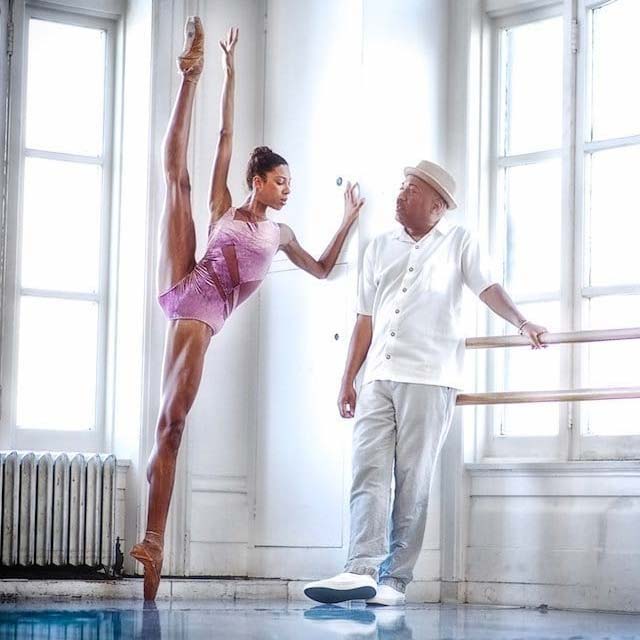A long-time presence in San Francisco, Alonzo King Lines Ballet Company has an international reputation for the liquid, catlike qualities of its dancers and artistic director Alonzo King’s distinctive blend of pointe shoe and contemporary ballet choreography that can morph in an instant from elegant to explosive. The company returns for performances at two local venues. On Saturday, May 27, Segerstrom Center for the Performing Arts hosts company in Costa Mesa. On Friday and Saturday, June 9 and 10, the dancers are in Beverly Hills at the Wallis Annenberg Center for the Performing Arts in Beverly Hills.
The calling card at both venues is Deep River, a heart-felt work that marked the company’s post-pandemic return to live performance and also launched the troupe’s 40th anniversary season last May. Reviewing the May 2022 premiere, San Francisco Chronicle critic Rachel Howard wrote “Seeing how these Black Christian spirituals could meld so naturally with dance imagery that suggests influences from both yogic philosophy and Islam, is a striking reminder of the universality King has reclaimed for ballet.” Datebook.

In a recent telephone interview, King talked about Deep River, his company’s longevity, and the underlying spiritual/physical approach that distinguish the dancers, the company, and his dance making.
The initial question was what was the spark for Deep River as the work for the 40th anniversary?”
King: “During the pandemic, we were given a lot of support by organizations to build bubbles so that we could continue to work, because the premise was artists should continue to do what they do. The goal eventually became doing a work for the 40th anniversary, and collecting some of the people we have worked with a long time.”

That collection effort reunited King with two of his frequent collaborators Lisa Fischer and Jason Moran.
Grammy-award winning vocalist Fischer was the subject of the academy award winning documentary ‘Twenty Feet from Stardom.” This time Fischer is in the thick of the onstage action, singing among the dancers. action. From available video clips of Deep River, she may not consider herself a dancer, but like her singing, she certainly knows how to move with the music.

MacArthur genius award-winning composer Moran is artistic director of Jazz at the Kennedy Center among his other laurels. For Deep River, Moran not only composed and arranged, he collaborated in adding jazz moments by Pariah Sanders, James Weldon Johnson, and the Maurice Ravel.
King: “Jason and Lisa are both extraordinary artists. I just feel a strong kinship with their interpretation and creativity, and even more because I don’t separate that from who they are as human beings. They are selflessly generous and always living in a state of gratitude, really glad about their lives. So who wouldn’t want to hang around with those people?”
“Voices like Lisa’s, it is always more than the beauty of the sound. It’s the intuition, the intelligence that is behind all of it. Her understanding was what was at work, bringing something naturally and I could say ‘That’s it.” Because that’s what we’re trying to do, relax and be ourselves.”

“These are people I adored and there were wonderful successes we had before, so it builds a team. Because you’ve worked with people, you know them and they know you, it’s easier. You have a language, not even a language, a sense of their hearing, of non-verbal communication, about places to go. So anyone throwing out seed ideas that come through words, you have responses that comes from that intuitive collaboration.”
In an interview several years ago when Moran and King collaborated at the Vail Dance Festival, Moran described how he writes down melodies then sets them aside, then collaboration often starts over dinner.
“The melody sits on my piano or in my head until Alonzo calls and says let’s have dinner and the melody says, well, I want to go too, and I end up taking the melodies along and ask if there is anything there. Our most frequent conversations is about space. The music is about space. Does the music have enough space for the body to be in conversation with the melody.” Moran told the Vail interviewer.
An anomaly was how music by Maurice Ravel came to be included in the jazz-infused Deep River?
King: “Ravel’s “Kaddish” is incredible, and something I’ve wanted to do for a long time. So we have this combination of spiritual songs from the African American community, from the Jewish community, and other combinations that were chosen because they were deeply heartfelt and we wanted to aim the arrow directly toward the heart. We wanted to address the idea that regardless of what you’re going through, no matter how difficult things are, there is a choice for another focus and nothing lasts forever, inevitably things will change.”
“Something that everyone has in common is that they want to avoid pain and suffering, and they want some kind of joy that never goes stale. That’s it, across the board. So a lot of it is how to live life, how to not give up, and how there is something deep inside of us that can overcome any obstacle we ask and access it to.
For me, my obsession is that the ideas are clear and that regardless, and this surprises people for some reason, regardless of the discipline or the occupation, we’re all doing the same thing. One of the things that people who are serious about their lives do is they are always interested in self-reform, how can I be clearer, how can I be concise, how can I be improved? And that goes from painting, writing, living your life, whatever is affirmation, improvement, and expansion, that is where my eye is going.”
After four decades, King’s approach has extended far beyond the dance company to a collaborative BFA program with Dominican College, the dance center, and extensive community programs.
King sees the myriad aspects of LINES as logical extensions of the vision of the founding trio who set out to start the dance company.
King: There were three of us, Pam Hagen, Robert Rossenwasser and me. We had worked together in Santa Barbara, came to San Francisco and decided to start a company. The idea of a company was always there. When we first came to San Francisco, there were tons of students, a very positive environments among directors and dance makers, and we decided to build a company. The seed for a dance company was always there but it began with classes.

Why did they choose San Francisco?.
King: I lived in New York for a long time and I grew up in Santa Barbara. In New York I found myself trying to find some nature and I could not take it after awhile. I returned to Santa Barbara first. I knew I did not want to go to Europe. I had spent time in Europe and wanted to live in America. San Francisco was a vibrant dance center and it was close to nature.
Asked why the company is called LINES, King initially quips that the names that he wanted were taken, but then turns to a recurring theme of the interrelationship of dance and the natural world.
King: “When we look in nature, everything is in phenomena is straight line or circle. We believe that the union of the east and west, whether left brain or right brain, whether female or male, whether feeling or logic, there was a necessity for balance that we wanted embodied in the company and the teaching. The name reflects that.”
Videos of King teaching class reflect a distinctive approach that emphasizes avoiding what dancers think are their limits, but instead providing cues for dancers to find things inside themselves that can take their bodies beyond accepted limitations.

The strongest evidence for King’s approach is not in the photos of LINES’ often unworldly lithe, long-limbed dancers that the company is known for, but in how LINES dancers move on the way to and from a particular position that might end up captured in a photo.
King: “When people are new I sometimes have to say ‘stop posing’, this isn’t a photographic session. You have to live in the moment. A dancer is singing the music, just as a musician is dancing the music. A dancer is the embodiment of the idea, not the steps. Steps can be expressed academically in beautiful bodies, yet seem small. What is really important here, is the mind and the heart. I’m working with human beings who I challenge to inhabit their genius and at the same time challenge them to be little kids and follow the idea where the dance goes.
As a dancer, I might have an idea about a role, how I would dance it, how it will look on me, and I have to get rid of that. What needs to happen is asking what does the role require? To forget about myself for awhile, to give an impersonal analysis and think about what should this be to become to be the most luminous? That’s a most beautiful place to be because you are in the service of the idea, instead of wanting to be liked and seeking applause.
Dancers scheduled to perform at both venues include Babatunji, Adji Cissoko, Madeline DeVries, Theo Duff-Grant, Lorris Eichinger, Shuaib Elhassan, Joshua Francique, James Gowan, Ilaria Guerra, Maya Harr, Marusya Madubuko, Michael Montgomery and Tatum Quiñónez.
Alonzo King Lines Ballet Company in Deep River — At Segerstrom Center for the Arts, 600 Town Center Dr., Costa Mesa; Sat., May 27, 7:30 pm, $29-$109. SCFTA.
Also at The Wallis Annenberg Center for the Performing Arts, 9390 N. Santa Monica Blvd., Beverly Hills; Fri.-Sat., June 9-10, 7:30 pm, $39-$125. The Wallis.
More about Alonzo King LINES Ballet on their site. Preview clips of Deep River on YouTube.
A portion of a company class conducted in 2016 by King. YouTube.
